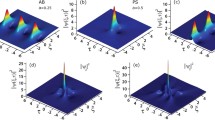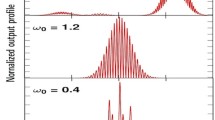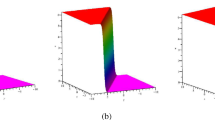Abstract
The formation of breathers as prototypes of freak waves is studied within the framework of the classic ‘focussing’ nonlinear Schrödinger (NLS) equation. The analysis is confined to evolution of localised initial perturbations upon an otherwise uniform wave train. For a breather to emerge out of an initial hump, a certain integral over the hump, which we refer to as the “area”, should exceed a certain critical value. It is shown that the breathers produced by the critical and slightly supercritical initial perturbations are described by the Peregrine soliton which represents a spatially localised breather with only one oscillation in time and thus captures the main feature of freak waves: a propensity to appear out of nowhere and disappear without trace. The maximal amplitude of the Peregrine soliton equals exactly three times the amplitude of the unperturbed uniform wave train. It is found that, independently of the proximity to criticality, all small-amplitude supercritical humps generate the Peregrine solitons to leading order. Since the criticality condition requires the spatial scale of the initially small perturbation to be very large (inversely proportional to the square root of the smallness of the hump magnitude), this allows one to predict a priori whether a freak wave could develop judging just by the presence/absence of the corresponding scales in the initial conditions. If a freak wave does develop, it will be most likely the Peregrine soliton with the peak amplitude close to three times the background level. Hence, within the framework of the one-dimensional NLS equation the Peregrine soliton describes the most likely freak-wave patterns. The prospects of applying the findings to real-world freak waves are also discussed.
Similar content being viewed by others
References
Benjamin TB, Feir JE (1967) The disintegration of wavetrains in deep water. Part 1. J Fluid Mech 27: 417–430
Benney DJ, Roskes GJ (1969) Wave instabilities. Stud Appl Math 48: 377–385
Peregrine DH (1983) Water waves, nonlinear Schrödinger equations and their solutions. J Aust Math Soc Ser B 25: 16–43
Osborne AR, Onorato M, Serio M (2000) The nonlinear dynamics of rogue waves and holes in deep-water gravity wave trains. Phys Lett A 275: 386–393
Dyachenko AI, Zakharov VE (2005) Modulational instability of Stokes waves → freak wave. JETP Lett 81: 255–259
Kharif C, Pelinovsky E (2003) Physical mechanisms of the rogue wave phenomenon. Eur J Fluid Mech B/Fluids 22: 603–634
Kharif C, Pelinovsky E, Slyunyaev A (2009) Rogue waves in the ocean. Springer, Berlin
Song J-B, Banner ML (2002) On determining the onset and strength of breaking for deep water waves. Part I: unforced irrotational wave groups. J Phys Oceanogr 32: 2541–2558
Tanaka M (1990) Maximum amplitude of modulated wave train. Wave Motion 12: 559–568
Alber IE (1978) The Effects of Randomness on the Stability of Two-Dimensional Surface Wave trains. Proc R Soc Lond A 363(1715): 525–546
Janssen PAEM (1983) Long-time behaviour of a random inhomogeneous field of weakly nonlinear surface gravity waves. J Fluid Mech 133: 113–132. doi:10.1017/S0022112083001810
Stiassnie M, Regev A, Agnon Y (2008) Recurrent solutions of Alber’s equation for random water-wave fields. J Fluid Mech 598: 245–266
Janssen PAEM (2003) Nonlinear four-wave interactions and freak waves. J Phys Oceanogr 33: 863–884
Annenkov S, Shrira V (2009) Evolution of kurtosis for wind waves. Geophys Res Lett 36: L13603. doi:10.1029/2009GL038613
Osborne AR, Onorato M, Serio M (2005) Nonlinear Fourier analysis of deep-water random surface waves: theoretical formulation and and experimental observations of rogue waves. 14th Aha Huliko’s Winter Workshop, vol 25. Honolulu, Hawaii, pp 16–43
Islas LA, Schober CM (2005) Predicting rogue waves in random oceanic sea states. Phys Fluids 17: 0317011-4
Slunyaev A, Pelinovsky E, Guedes Soares C (2005) Modelling freak waves from the North Sea. Appl Ocean Res 27: 12–22
Slunyaev A (2006) Nonlinear analysis and simulations of measured freak wave time series. Eur J Mech -B Fluids 25: 621–635
Akhmediev N, Ankiewicz A, Taki M (2008) Waves that appear from nowhere and disappear without a trace. Phys Lett A 373: 675–678
Mei CC, Stiassnie M, Yue DK-P (2005) Theory and applications of ocean surface waves. World Sci
Janssen PAEM (2004) The interaction of ocean waves and wind. Cambridge University Press, Cambridge
Zakharov VE, Shabat AB (1971) Exact theory of two-dimensional self-focusing and one-dimensional self-modulation of waves in nonlinear media. Zh Eksp Teor Fiz 61: 118–134
Ablowitz MJ, Kaup D, Newell A, Segur H (1974) The inverse scattering transform: Fourier analysis for non-linear problems. Stud Appl Math 53: 249–315
Newell AC (1985) Solitons in physics and mathematics. SIAM
Novikov SP, Manakov SV, Pitaevskii LP, Zakharov VE (1984) Theory of solitons: the inverse scattering method (Monographs in contemporary mathematics). Springer, 1984, 292 pp. (ISBN: 0306109778)
Dysthe KB, Trulsen K (1999) Note on breather type solutions of the NLS as models for freak-waves. Phys Scripta T82: 48–52
Ma Ya-C (1979) The perturbed plane-wave solutions of the cubic Schrödinger equation. Stud Appl Math 60: 43–58
Kuznetsov EA (1977) Solitons in a parametrically unstable plasma. Sov. Phys. - Dokl. (Engl. Transl.), 1977, 22, 507–508. On solitons in parametrically unstable plasma. Doklady USSR 236:575–577 (in Russian)
Akhmediev NN, Eleonskii VM, Kulagin NE (1987) Exact first-order solutions of the nonlinear Schrödinger equation. Theor Math Phys 72: 809–818
Slunyaev A (2005) Interaction of envelope soliton with a plane wave in nonlinear Schrödinger equation. Izvestia of Prochorov Academy of Engineering Sciences 14: 41–46 (in Russian)
Dold JW, Peregrine DH (1986) Water-wave modulation. 20th international conference on coastal engineering, Taipei, vol 1. pp 163–175
Henderson KL, Peregrine DH, Dold JW (1999) Unsteady water wave modulations: fully nonlinear solutions and comparison with the nonlinear Schrödinger equation. Wave Motion 29: 341–361
Clamond D, Francius M, Grue J, Kharif C (2006) Long time interaction of envelope solitons and freak wave formations. Eur J Mech B Fluids 25: 536–553
Shemer L, Goulitski K, Kit E (2007) Evolution of wide-spectrum unidirectional wave groups in a tank: an experimental and numerical study. Eur J Mech B/Fluids 26: 193–219
Landau LD, Lifshitz EM (1998) Quantum mechanics. Butterworth-Heinemannn, Oxford
Akhmediev N, Soto-Crespo JM, Ankiewicz A (2009) Extreme waves that appear from nowhere: on the nature of rogue waves. Phys Lett A 373: 2137–2145
Dyachenko AI, Zakharov VE (2008) On the formation of freak waves on the surface of deep water. JETP Lett 88: 307–311
Onorato M, Osborne AR, Serio M (2004) Observation of strongly non-Gaussian statistics for random sea surface gravity waves in wave flume experiments. Phys Rev E 70(6): 067302
Lavrenov IV (1998) The wave energy concentration at the Agulhas current off South Africa. Nat Hazards 17: 117–127
Onorato M, Waseda T, Toffoli A, Cavaleri L, Gramstad O, Janssen PA, Kinoshita T, Monbaliu J, Mori N, Osborne AR, Serio M, Stansberg CT, Tamura H, Trulsen KM (2009) Statistical properties of directional ocean waves: the role of the modulational instability in the formation of extreme events. Phys Rev Lett 102(11): 114502
Annenkov S, Shrira V (2009) ‘Fast’ nonlinear evolution in wave turbulence. Phys Rev Lett 102: 024502
Author information
Authors and Affiliations
Corresponding author
Rights and permissions
About this article
Cite this article
Shrira, V.I., Geogjaev, V.V. What makes the Peregrine soliton so special as a prototype of freak waves?. J Eng Math 67, 11–22 (2010). https://doi.org/10.1007/s10665-009-9347-2
Received:
Accepted:
Published:
Issue Date:
DOI: https://doi.org/10.1007/s10665-009-9347-2




